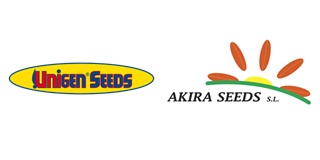
UNIGEN SEEDS SPAIN
Good results of a using 0.01 kJ m?2 UVC irradiation dose as postharvest physical treatment to control the banana crown rot disease
Crown rot caused by fungal pathogen (*) is the most prevalent postharvest disease in banana fruit that results significant economic losses during transportation, storage, and ripening period. Antifungal effects of ultraviolet C (UVC) irradiation at doses varied from 0.01 to 0.30 kJ m?2 were investigated in controlling postharvest crown rot disease, maintenance of fruit quality, and the effects on antioxidant capacity of Berangan banana fruit during ripening days at 25 ? 2?C and 85% RH. Fruits irradiated with 0.30 kJ m?2 exhibited the highest (i.e., 62.51%) reduction in disease severity. However, the application of UVC at all doses caused significant browning damages on fruit peel except the dose of
26 June, 2017
Crown rot caused by fungal pathogen (*) is the most prevalent postharvest disease in banana fruit that results significant economic losses during transportation, storage, and ripening period.? Antifungal effects of ultraviolet C (UVC) irradiation at doses varied from 0.01 to 0.30 kJ m?2 were investigated in controlling postharvest crown rot disease, maintenance of fruit quality, and the effects on antioxidant capacity of Berangan banana fruit during ripening days at 25 ? 2?C and 85% RH. Fruits irradiated with 0.30 kJ m?2 exhibited the highest (i.e., 62.51%) reduction in disease severity. However, the application of UVC at all doses caused significant browning damages on fruit peel except the dose of 0.01 kJ m?2. This dose synergistically reduced 46.25% development of postharvest crown and did not give adverse effects on respiration rate, ethylene production, weight loss, firmness, color changes, soluble solids concentration, titratable acidity, and pH in banana as compared to the other treatments and control. Meanwhile, the dose also enhanced a significant higher level of total phenolic content, FRAP, and DPPH values than in control fruits indicating the beneficial impact of UVC in fruit nutritional quality. The results of scanning electron micrographs confirmed that UVC irradiation retarded the losses of wall compartments, thereby maintained the cell wall integrity in the crown tissue of banana fruit. The results suggest that using 0.01 kJ m?2 UVC irradiation dose as postharvest physical treatment, the crown rot disease has potential to be controlled effectively together with maintaining quality and antioxidant of banana fruit. The graphic shows the effect of different ultraviolet C doses on crown rot disease severity that naturally infected on Berangan banana fruit during ripening at 25 ? 2?C and 85% RH? SourcesSheikh Mohamed NT, Ding P, Kadir J, M. Ghazali H. Potential of UVC germicidal irradiation in suppressing crown rot disease, improving postharvest quality and antioxidant capacity of Musa AAA ?Berangan? during fruit ripening. Food Sci Nutr. 2017:00:1?14. https://doi.org/10.1002/fsn3.482 (*) "Crown rot is the result of the activity of a fungal complex. The microorganisms most commonly isolated in crown rot are: Musicillium theobromae, Colletotrichum musae, Ceratocystis paradoxa, Lasiodiplodia theobromae, Nigrospora sphaerica, Cladosporium sp., Acremonium sp., Penicillium sp., and Aspergillus sp., as well as many Fusarium spp., including F. semitectum, F. verticillioides, F. sporotrichoides, F. oxysporum, and F. solani (9,40,42,52,66,68, 73,78,87,98,99)." In?Crown rot of bananas - Preharvest factors involved in postharvest disease development and integrated control methods









